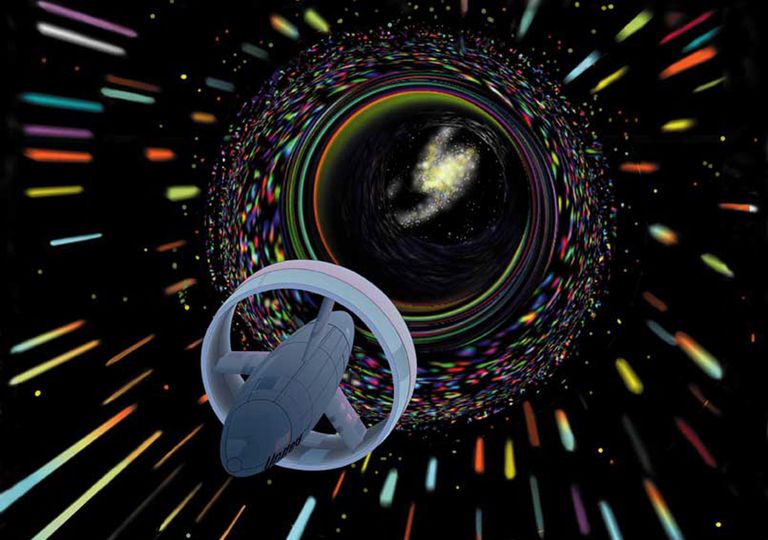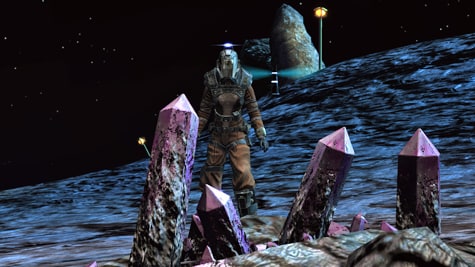
Posted on 09/27/2019 10:52:10 AM PDT by Red Badger

Warp drive is one of the many futuristic ideas proposed in Star Trek, allowing for faster-than-light travel across the galaxy. Einstein's Theory of Relativity prevents anything from moving faster than light.
In 1994, a theoretical physicist proposed a workaround: creating a bubble within space-time that would twist distances, allowing anything within the bubble to travel long distances. Many think it makes theoretical sense, but is practically unworkable.
An undergrad at the University of Alabama wants to restart the conversation, and he's focused on how much energy such a bubble would need.
Star Trek's science fiction has been intermingled with real-life science for decades. The franchise has inspired technologies that people use and study every day, and now a mechanical engineering student at the University of Alabama in Huntsville wants to bring forth another one: warp drive.
Warp drive is fundamental to the world of Star Trek, as it's the crucial component to superluminal starships. Without these super-fast ships that run on warp drive, we can't become a space-faring species. Thus, warp drive is tremendously important to humanity's evolution.
But Einstein's Theory of Relativity kind of throws a wrench into the whole thing, since nothing can travel faster than the speed of light.
"As objects travel faster and faster, they get heavier and heavier—the heavier they get, the harder it is to achieve acceleration, so you never get to the speed of light," Roger Rassool, a physicist at the University of Melbourne, Australia, once told the BBC. Only things with no mass, like photons, can travel at those tremendous speeds. That certainly rules out massive ships like the Enterprise.
In 1994, the theoretical physicist Miguel Alcubierre developed a theoretical workaround, which has come to be known as the Alcubierre drive. "By a purely local expansion of spacetime behind the spaceship and an opposite contraction in front of it," Alcubierre wrote in his paper's abstract, "motion faster than the speed of light as seen by observers outside the disturbed region is possible."
Essentially, an Alcubierre drive would expend a tremendous amount of energy to contract and twist space-time in front of it and create a bubble. Inside that bubble would be a inertial reference frame where explorers would feel no proper acceleration. The rules of physics would still apply within the bubble, but the ship would be localized outside of space.
The engineering student, Joseph Agnew, wants to explore the idea. "Mathematically, if you fulfill all the energy requirements, they can’t prove that it doesn’t work," he recently said at a standing-room only talk on the subject.
"Suppose you have a craft that’s in the bubble," he continues, quoted in a university press release on the talk. "What you would do is, you’d compress space-time ahead of the craft and expand space-time behind it."
The energy required to create an Alcubierre bubble would be immense. Some scientists believe it would require more energy than available within the universe, although others maintain the energy levels would be physically attainable. Agnew believes it can go down further.
"People used to say, ‘You’re dealing in something that would be great, but it takes the mass of the entire universe to do it,’" Agnew said. "Now, we’re down to where it is still an immense amount of energy and exotic matter is still a problem, but if we had that energy, we could do it."
After five to eight years of theoretical work, Agnew said, "it’s been reduced by many, many orders of magnitude."
To remove the fictional element of the bubbles, Agnew would want to start small. "Some people have approached it on a spacecraft-size scale, like what will it take to do this at that really large range, and some have approached it from a ‘Can we create this effect in a lab and then scale it up?’ perspective," he said. Even the smallest bubble would be a tremendous scientific breakthrough.
Of course, there's more to travel than just being able to generate enough energy to create a road. There's also the not-insignificant matter of surviving the trip.
"On one side, an observer located at the center of a superluminal warp-drive bubble would generically experience a thermal flux of Hawking particles," reads the abstract to a study from 2009 that discusses theorized Hawking radiation, a theoretical type of radiation released by black holes.
"On the other side, such Hawking flux will be generically extremely high if the exotic matter supporting the warp drive has its origin in a quantum field satisfying some form of Quantum Inequalities." The Hawking radiation would theoretically kill anyone who attempted to enter such a bubble.
So there's a long road ahead. But that's not deterring Agnew. He's curious about exploring the field further, on one condition: funding.
"The interest in doing something in this field is going to be there if someone has the money," he said. "This is just one of several areas I am interested in. If the opportunity is there to do it, I’ll pursue it."
This is just BS extracted from the mind of nully, but, suppose there really is aether?
The only “proof” we have that there isn’t is the Michelson–Morley experiment, an experiment that has only been done on the surface of the Earth. Suppose the aether swirls like the eddies around an oar or water flowing down a drain?
Stuff accumulates in these eddies/vortexes, every planet, every star and every galactic feature is defined by these eddies. If you look at an eddies in the 2 dimensional water model you can see striations on the walls, these correspond to the 3 dimensional arms in galaxies.
Back to Michelson–Morley experiment, done on the surface of the Earth only. The mass accumulation and the rotational velocity mirror the rotation of the aether vortex. The revolution of the Earth around the Sun tracks the swirl of the aether spinning around the Sun. After billions of years the interaction of aether and matter more or less reach an equilibrium. Surface velocity on a massive object is more or less zero, exactly as Michelson and Morley found. In effect, the were attempting to measure the velocity of the wind from a balloon floating freely in and with the breeze.
Why do some galaxies show anomalous rotation? The centers of most galaxies have a black hole where space-time spirals in. Does the fabric of space-time have a yield strength?
If so, as the black hole continues to gain mass, the very fabric of space-time stretches as the gravity well gets deeper and deeper. If at any point the strain exceeds the yield stress of space-time the funnel tears in two at that depth. Everything below that tear falls off into a separate universe.
Everything above? It rebounds. More space pours out of the old event horizon, as the mass that was holding it in place has budded off and as far as this universe can tell, simply ceased to exist. All the matter on the sidewalls above the new event horizon barfs out along with the space and forms the central bar seen on so many galaxies. For a time the bottom of the gravity well looks flat, and this flat gravitational gradient allows the matter to rotate around the core at the same rate rather than faster towards the center (which no longer has a steeper slope) than the edge.
You see a similar effect if you abruptly close a drain valve.
However, astronomers have recently discovered galaxies which appear to have no dark matter.
Their center black hole simply hasn’t developed a steep enough stress gradient to bud off. Yet.

I had a warped drive once..
I believe the Warp scale in Star Trek is logarithmic. Therefore, Warp 5 is 100,000x the speed of light.
“Warp 2, Mr. Sulu.”
I like your theory. It could explain the Boötes void.
NBD! Back in the 40’s, the neighborhood I lived in had lots of vehicles with wop drive (mine included)...
Also, I am not sure space IS ‘empty’ either.
If you take an empty cube of space, and shine a light through it, it comes out the other side- what exists inside the ‘space’ when the light is traveling through it?
“creating a bubble within space-time that would twist distances”
Nothing but words with no reality behind them. “bubble within space-time” does not designate any reality. It’s assumed that he can create that. Invalid assumption.
Keep trying.
Yeah, well if "for every action, there is an opposite and equal reaction", then the matter of the ship getting heavier will be compensated by what's thrown out the back.
So while Eisenstein's theory certainly applies to anything 'pushed' by an external force, such as occurs inside particle accelerators, etc., I'm not convinced it applies to a self-contained reaction force propulsion system.
With the very sensitive measuring devices that exist today, we should be able to devise an experiment that proves or disproves that self-contained reaction force propulsion systems are also affected.
Besides the above, such an experiment would also serve to establish a new speed record for something built by mankind, among other worthwhile science packages that could be attached to such a craft/probe to offset the cost. :-)
Yeah, but after warp 5, space begins to crack.
-PJ
You know those speed bumps that compel drivers to slow down lest they risk tearing the car's transmission to pieces? Hitting the tiniest piece of space debris would be much worse.
Seriously? If these ‘scientists’ are so d@mn smart, WHERE is my Flying Car? Huh? Huh?
I’ve been WAITING since 1960! ;)
Yes, that is exactly what is described in this post.
According to Star Trek, warp 1 is L: 186,000 miles per second.
Warp 2 is L cubed. LXLXL :1,196,883,216,000,000,000,000 miles per second.
And so on.
Hope they take the carpool lane!
A black hole is a “bubble within space-time”. And it's event horizon serves as kind of proof that matter can indeed exceed the speed of light, at least within such a bubble.
“Warp 2 is L cubed. LXLXL :1,196,883,216,000,000,000,000 miles per second.”
Good God, no wonder the engines were always buckling. ;>)
Can’t Congress simply enact these velocities with legislation? Hasn’t the United Nations done this already?
Disclaimer: Opinions posted on Free Republic are those of the individual posters and do not necessarily represent the opinion of Free Republic or its management. All materials posted herein are protected by copyright law and the exemption for fair use of copyrighted works.